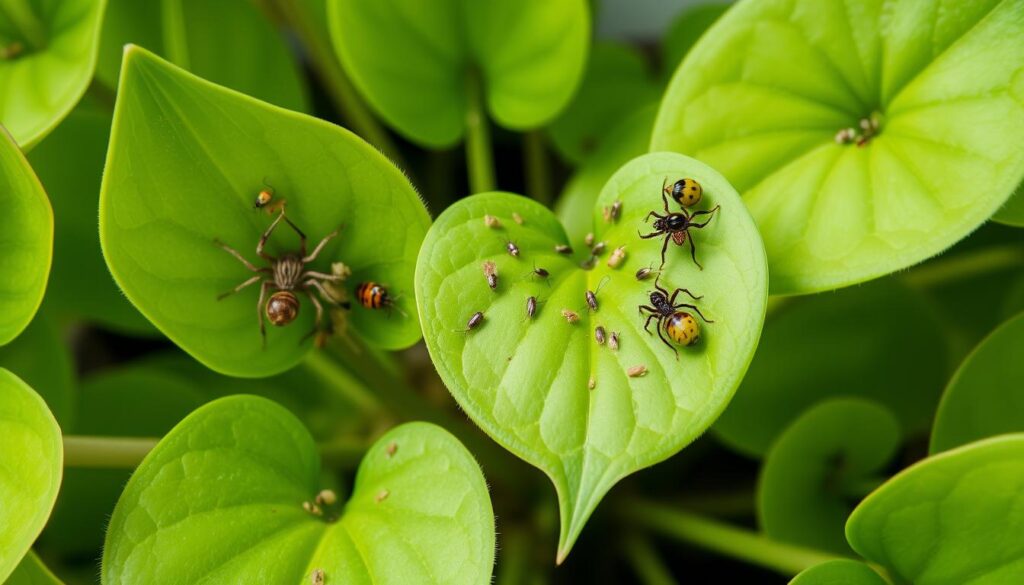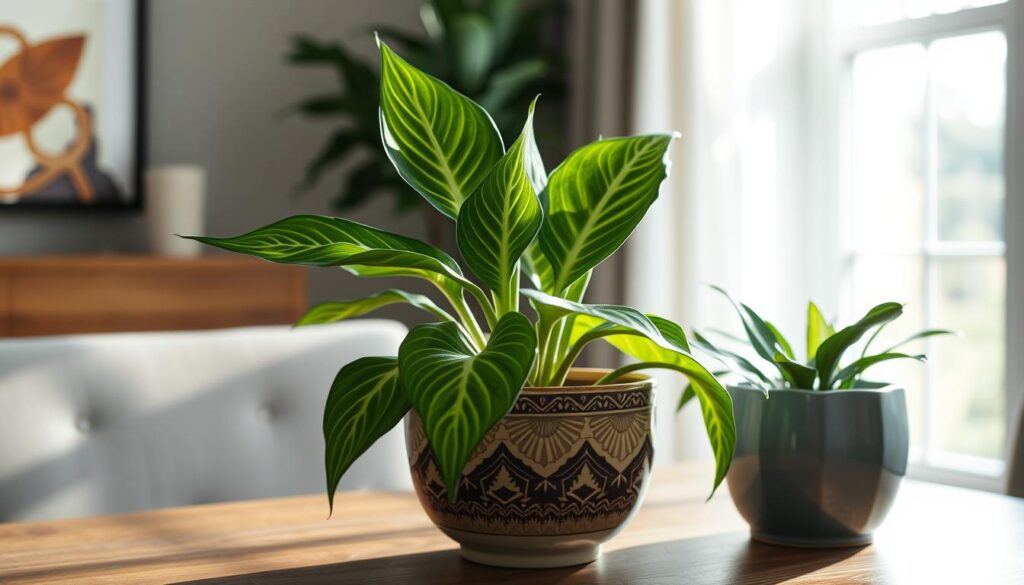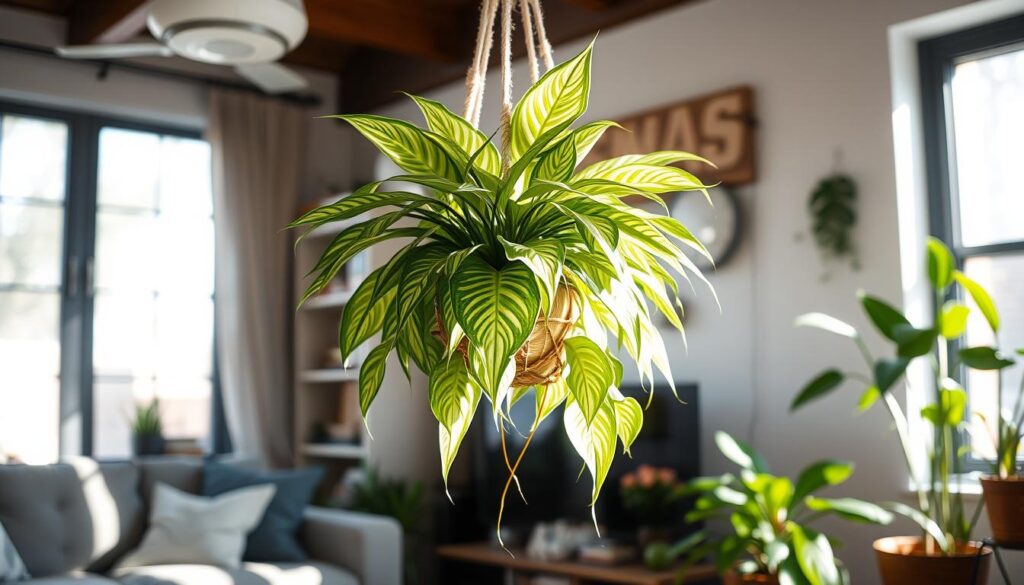The arrowhead plant, also known as Syngonium podophyllum, is a stunning houseplant. It adds elegance to any indoor space. Its arrow-shaped leaves and vibrant colors make it a favorite among plant lovers.
The arrowhead vine is versatile and attractive. It can thrive in various indoor conditions. For more information on growing the arrowhead plant indoors, visit arrowhead plant care to learn more about its unique needs.
Table of Contents
Introduction to the Arrowhead Plant
The arrowhead plant, also known as the syngonium plant, is a favorite for indoor gardens. It has arrow-shaped leaves and is easy to care for. It does well in medium to low light, perfect for rooms with little sunlight.
Having an arrowhead plant indoors is great because it purifies the air and makes spaces look better. Its leaves can grow up to 6 inches long. This adds elegance to any room.
Overview of the Plant’s Characteristics
- Arrow-shaped leaves with variegated patterns
- Can grow up to 6 inches long
- Low-maintenance requirements
- Can thrive in medium to low light conditions
Benefits of Having Arrowhead Plants Indoors
The arrowhead plant is not just pretty; it also purifies the air. With the right care, it can be a stunning addition to any indoor garden. To keep it thriving, follow the care guidelines for watering, fertilizing, and pruning.
Ideal Growing Conditions for Arrowhead Plants
Arrowhead plants, also known as american evergreen or syngonium arrowhead vine, are loved for their unique, arrow shaped leaves. To make sure they grow well, it’s key to give them the right environment. They like bright, indirect light but can also do okay in low light.
Light Requirements
Direct sunlight can burn their leaves. So, it’s best to put them near a north-facing window. Or, use a sheer curtain to soften the light. This keeps your american evergreen plant happy.
Temperature and Humidity Needs
The best temperature for syngonium arrowhead vine is 65-75°F (18-24°C). They also need high humidity to prevent leaf drop. You can boost the humidity by placing the plant on a tray with water and pebbles. Or, use a humidifier. By meeting their needs, your plants with arrow shaped leaves will stay healthy and look great.
How to Care for Your Arrowhead Plant
To keep your syngonium nephthytis, also known as the maria arrowhead plant, thriving, it’s essential to provide the right care. This includes watering, soil, and fertilization guidelines. Proper nephthytis care involves consistent moisture, but overwatering can lead to root rot. Check the soil moisture by sticking your finger into the soil up to the first knuckle. If the soil feels dry, it’s time to water.
A well-draining potting mix is crucial to prevent waterlogged soil. A combination of equal parts potting soil, perlite, and sand provides optimal drainage. For fertilization, use a balanced, water-soluble fertilizer during the growing season (spring and summer) to promote healthy growth and vibrant foliage. This will help your maria arrowhead plant flourish and grow long vines.
Watering Guidelines
Water your arrowhead plant when the top 2 inches of soil are dry to the touch. This will help prevent overwatering and root rot. It’s also essential to maintain humidity levels between 40% and 60% for optimal growth.
Soil Recommendations
A well-draining potting mix is essential for your syngonium nephthytis. Avoid using regular potting soil, as it can retain too much water and cause root rot. Instead, opt for a mix specifically designed for tropical plants like the maria arrowhead plant.
Fertilizing Tips
Fertilize your arrowhead plant monthly during the spring and summer with a balanced liquid fertilizer. This will provide the necessary nutrients for healthy growth and vibrant foliage. You can also use seaweed-based organic fertilizers, which provide growth hormones and micronutrients vital for all indoor plants during active growth periods.
By following these nephthytis care guidelines, you’ll be able to keep your maria arrowhead plant happy and thriving. Remember to inspect your plant regularly for signs of pests or diseases, and prune it as needed to maintain its shape and promote healthy growth.
Common Pests and Problems
The syngonium butterfly plant, also known as the exotic allusion arrowhead plant, can face pests and diseases. It’s important to check your plant often to stop infestations early. Pests like mealybugs, spider mites, and scale can harm your plant.
Look for white, cottony patches, fine webbing, or brown spots on leaves to spot pests. Use insecticidal soap, neem oil, or horticultural oil to treat them. For fungal diseases, make sure air circulates well, water less, and use a fungicide if needed.

Identifying Pests
- Mealybugs: white, cottony patches on leaves
- Spider mites: fine webbing on the underside of leaves
- Scale: brown, armored spots on leaves
Treatment Options
To fight pests, use insecticidal soap, neem oil, or horticultural oil. Keep an eye on your plant and act fast to avoid big problems. This will help keep your syngonium butterfly plant or large arrowhead plant healthy.
Propagation Techniques
There are two main ways to propagate a mature arrowhead plant: stem cuttings and division. For stem cuttings, pick a healthy stem with at least two nodes. Cut it just below a node and remove the lower leaves. Then, put the cutting in water or a propagation tray until roots grow.
Division is another method. It involves splitting the plant into sections, each with a stem and roots. Then, replant them in well-draining soil. This method is good for creating new plants from an old one. The best time for this is in the spring and summer when the plant is growing fast.
Some important tips for successful propagation include:
* Use a potting mix that drains well, like a mix of soil, pumice, or perlite.
* Give the plant bright, indirect sunlight and keep the humidity high.
* Keep the soil moist but not too wet.
* Change the water weekly to stop bacteria and algae from growing.
By following these tips and using the right methods, you can grow more arrowhead plants. Enjoy the beauty and ease of these plants in your home.
Choosing the Right Pot for Your Arrowhead Plant
Choosing the right pot for your arrowhead plant is key. The pot should be a bit bigger than the plant’s roots. This lets the roots grow well. The arrowhead plant, with its arrow shaped leaf, can grow big if it has the right space.
Ceramic or terracotta pots are great because they breathe. They help prevent the soil from getting too wet. This is important for the arrowhead plant lifespan. Waterlogged soil can cause root rot and diseases. Good caring for an nephthytis means ensuring the soil drains well, which pots with holes can do.
Size and Material Considerations
The pot’s size depends on the plant’s size. A good rule is to choose a pot 1-2 sizes bigger than the current one. For example, a 4-inch pot can move to a 6-inch one. The pot’s material also matters, as it affects the soil’s moisture.
Drainage Importance
Drainage is vital for the arrowhead plant’s health. Wet soil can rot the roots and kill the plant. So, make sure the pot has holes at the bottom. If it doesn’t, drill holes or add gravel or pot shards to help with drainage.

Choosing the right pot is crucial for your arrowhead plant’s health and growth. Think about the pot’s size, material, and drainage. With the right care, your plant will flourish and add beauty to your home.
Popular Varieties of Arrowhead Plants
Arrowhead plants, also known as syngonium climber or arro plant, come in many varieties. Each has its own special features. The butterfly arrowhead plant is a favorite, with its beautiful, heart-shaped leaves.
Popular varieties include the White Butterfly, Pink Allusion, and Cream Allusion. They have different leaf colors and patterns, like green, white, and pink. This makes them perfect for any indoor space. The syngonium climber can grow well in various lighting conditions.
When picking an arrowhead plant, think about the leaf color, pattern, and look you want. Some, like the Pink Allusion, grow compactly. Others, like the White Butterfly, can get quite tall. The arro plant is ideal for those who want a low-maintenance, eye-catching plant.
The following table highlights some popular varieties of arrowhead plants:
| Variety | Leaf Color | Growth Habit |
|---|---|---|
| White Butterfly | Greenish-white | Tall, climbing |
| Pink Allusion | Light green with pink veins | Compact, bushy |
| Cream Allusion | Medium-sized creamy-green leaves | Trailing, climbing |
Choosing the right arrowhead plant variety can add elegance and beauty to your space. It also brings air-purifying benefits, making it a versatile choice.
Decorating with Arrowhead Plants
Arrowhead plants, also known as syngonium nephthytis, are great for decorating. They can hang from baskets or sit on tables. The hanging arrowhead plant adds greenery to any room. Use their arrow shaped leaves to make your indoor garden look good and healthy.
Here are some tips for decorating with arrowhead plants:
- Put them in hanging baskets for a cascading look
- Pair them with Pothos or Philodendron for a similar vibe
- Train them to climb up trellises or moss poles for a vertical touch
Adding plants with arrow shaped leaves like the arrowhead plant makes your indoor garden stand out. They clean the air and are easy to care for. They’re perfect for any home or office.

Troubleshooting Arrowhead Plant Issues
Arrowhead plants, also known as syngonium podophyllum, can face problems. These include yellowing leaves, leaf drop, and pests. You can fix these by changing how you care for the plant. This might mean better lighting, different watering, or pest treatment.
Yellow leaves often mean too much water or direct sun. To fix this, adjust the watering schedule so the soil is dry before watering again. Also, move the plant to a brighter, indirect light spot. Checking the plant often and acting fast can stop small problems from getting big.
- Yellowing leaves: Check for overwatering, underwatering, or insufficient light.
- Leaf drop: Adjust watering and humidity levels.
- Pest infestations: Treat with insecticidal soap or neem oil.
By following these tips and keeping up with proper care, your arrowhead plant syngonium will thrive in your indoor garden.
Enjoying Your Arrowhead Plant
The Arrowhead plant, or Syngonium podophyllum, can live for years with the right care. It adds beauty and purifies the air in your home. By following this guide, your Arrowhead plant will thrive and brighten your space.
Long-Term Care Tips
To keep your Arrowhead plant happy for years, give it the best conditions. It loves bright, indirect light and consistent moisture. High humidity is also important for its lush leaves.
Feed it regularly in spring and summer. This will help it grow strong and show off its colors.
Final Thoughts on Plant Enjoyment
The Arrowhead plant is perfect for both new and experienced gardeners. Its unique shape and air-purifying qualities make it a great choice. With the right care, your Arrowhead plant will bring lasting beauty and peace to your home.
Frequently Asked Question
Do arrowhead plants climb or hang?
Arrowhead plants, also known as Syngonium, are versatile! They naturally grow as climbing plants in their native habitats. Indoors, they can climb if you provide a moss pole or trellis. Without support, they often trail or hang beautifully, making them perfect for hanging baskets or letting their vines cascade from a shelf.
How do you take care of an arrowhead plant?
Arrowhead plants are low-maintenance! Place them in bright, indirect light (though they tolerate low light). Water when the top inch of soil feels dry but avoid overwatering. They like humidity, so mist the leaves or place a tray of water nearby. Use a balanced fertilizer monthly during spring and summer to keep it thriving.
What are the disadvantages of the arrowhead plant?
While beautiful, they can be toxic to pets and humans if ingested due to calcium oxalate crystals. Their fast growth may also require frequent pruning to prevent them from becoming unruly. Lastly, they can attract pests like spider mites if the environment is too dry.
Where is the best place to put an arrowhead plant?
A bright spot with indirect sunlight is ideal. East- or north-facing windows work well. Avoid direct sunlight, as it can scorch the leaves. Bathrooms and kitchens are great because of their naturally higher humidity levels.
How do I get my arrowhead plant to stand up?
To help your Arrowhead Plant stand upright, provide a moss pole or stake for support. As it grows, gently tie the vines to the support. Regular pruning can also encourage a bushier, more upright growth habit.
Can I put my arrowhead plant outside?
Yes, you can place your Arrowhead Plant outside in warm weather, but keep it in a shaded spot. Avoid direct sunlight and bring it inside when temperatures drop below 60°F.

